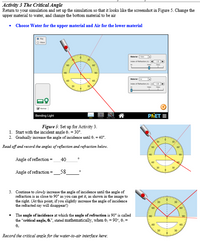Question
Hello,
I need filling out my table and answering #14?
Thank you!

Transcribed Image Text:Activity 3 The Critical Angle
Retum to your simulation and set up the simulation so that it looks like the screenshot in Figure 5. Change the
upper material to water, and change the bottom material to be air
• Choose Water for the upper material and Air for the lower material
Meri
do
nde of etacton
100
PŘET =
Bending Light
Figure 5: Set up for Activity 3.
1. Start with the incident angle e = 30°.
2. Gradually increase the angle of incidence until 0, = 40°.
Read off and record the angles of reflection and refraction below.
Angle of reflection =
40
Angle of refraction
58
3. Continue to slowly increase the angle of incidence until the angle of
refraction is as close to 90° as you can get it, as shown in the image to
the right. (At this point, if you slightly increase the angle of incidence
the refracted ray will disappear!)
60
The angle of incidence at which the angle of refraction is 90° is called
the "critical angle, 6.", stated mathematically, when e: = 90°, 6, =
30
Record the critical angle for the water-to-air interface here:

Transcribed Image Text:Reflection and Refraction
Critical angle for water-to-air, 6. =
87
Retum the angle of incidence to 0° and change the material in the top half to glass. Rotate the light source until
the refracted ray is at 90° to the surface nomal. Record the critical angle for glass-to-air.
Critical angle for glass-to-air, 6, =_89_
Repeat the process to find the critical angles for material Mystery A and Mystery B.
Record the results here:
There
Critical angle for Mystery A, 6. =
87
Critical angle for Mystery B, 6, =
89
Collect the critical angle results of each of the materials and enter these into Table 5 below, then calculate the
values for the third column in the Table 5.
Table 5: Data for Activity 3.
Material
Critical Angle, e.
sin 6.
Refractive index, n
Water
87
0.999
1.0014
Glass
89
0.991
1.5002
Mystery
Material A
87
0.999
1.00
Mystery
Material B
89
0.991
1.00
Q14. Complete the following statement. The index of refraction of the lower medium, which is air, is n =
_1.00027
Q15. Fill in the blanks. At the critical angle, the transmitted light makes an angle of
°, thus, sin 0:=
Now use Snell's Law to calculate for the index of refraction for each of the materials and enter these
values into the last column in Table 5.
Refer to Table 4 to identify the mystery materials.
Q16. Mystery
If your answers for n are not consistent with your earlier results and experiments, find out where the
discrepancy lies and re-do the experiment if necessary.
A is
_Mystery B is
Expert Solution
This question has been solved!
Explore an expertly crafted, step-by-step solution for a thorough understanding of key concepts.
This is a popular solution
Trending nowThis is a popular solution!
Step by stepSolved in 4 steps

Knowledge Booster
Similar questions
arrow_back_ios
arrow_forward_ios